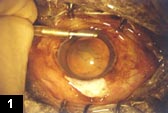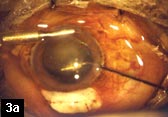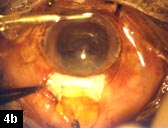Manual small-incision surgery an affordable alternative to ECCE, but training lags
Manual, sutureless small-incision cataract surgery is being embraced by surgeons in developing countries as a low-cost alternative to phacoemulsification that provides faster visual rehabilitation than standard extracapsular cataract extraction.
However, despite more than a decade of development, the procedure remains underutilized, as the demand for training outweighs the ability of facilities to provide instruction.
According to Ravi Thomas, MD, an ophthalmologist at L.V. Prasad Eye Institute in Hyderabad, India, standard extracapsular cataract extraction (ECCE) remains the most common surgical technique among Indian ophthalmologists, but manual small-incision cataract surgery (MSICS) — the name given to such manual, sutureless cataract surgery — is rapidly growing in popularity as intracapsular cataract surgery is phased out. Dr. Thomas said that conferences and training programs on MSICS are frequently overbooked.
“I don’t think standard ECCE is preferred over MSICS. I think training in MSICS is not available and hence is the reason standard ECCE remains popular,” he told Ocular Surgery News in an interview.
“Ophthalmologists want to compete by offering an inexpensive, sutureless surgery,” he said.
Overview of MSICS
According to Parikshit Gogate, MS(Ophth), an ophthalmologist at HV Desai Eye Hospital in Hadapsar, India, MSICS was first advanced during the 1990s by Michael Blumenthal, MD, an ophthalmologist in Israel. Similar techniques were pioneered by surgeons in the United States, and the Aravind Eye Hospital in Madurai popularized such techniques in India.
He said MSICS is different from both phacoemulsification and ECCE. The nucleus is broken into two or more parts and extracted through the incision in pieces. The procedure uses the same instruments as standard ECCE, but a 5- to 7-mm scleral tunnel incision is made with a keratome blade or diamond knife. In contrast, standard ECCE uses an incision of 10 mm to 12 mm in size.
Dr. Gogate said there are several techniques of MSICS, which mainly differ in the method of extracting the nuclear fragments. Dr. Gogate’s preferred technique, called viscoexpression, uses viscoelastics to deliver the fragments through the incision. Dr. Blumenthal’s technique involves the addition of a separate side-port incision and an anterior chamber maintainer. In this method, irrigating fluid delivers the fragments (Figures 1 to 4).
| ||||||||||
In other techniques, such as phacofracture, the nucleus was also bisected or trisected. In the phaco-sandwich technique, the nucleus was delivered between two instruments, while another variation delivered it using a lens loop.
Dr. Gogate noted that MSICS is not any more painful for the patient than ECCE or phacoemulsification. But more iris handling is required, and it is easier to perform using peribulbar, parabulbar or sub-Tenon’s anesthesia. Also, the MSICS wound is self-sealing, while an ECCE incision commonly requires three to five sutures to close.
Affordable alternative
According to Drs. Thomas and Gogate, one of the advantages to performing MSICS is that it does not require expensive equipment, such as a phacoemulsifier. Also, it incorporates the benefits of a smaller incision, such as less induced astigmatism. There is no suturing, and it has a faster postop recovery.
Dr. Thomas conceded that phacoemulsification can be performed through a smaller incision. However, he said, in India PMMA lenses are normally implanted, which require the wound to be extended up to 5.5 mm. “The induced astigmatism advantage for phaco is present only if a foldable lens is used,” he said.
“Also, the difference in induced astigmatism between a 3-mm phaco incision and a 5.5-mm MSICS incision is only about 0.3 D of induced cylinder. To obtain this, the surgeon would have to use an expensive machine, disposables and a foldable lens,” he said. “The cost of a foldable lens alone would allow for an additional six cataract operations using MSICS, including the cost of the [PMMA] lenses.”
Overall costs comparable
According to Dr. Gogate, the overall costs for performing MSICS, including all costs related to instruments, staffing and hospital facilities, are comparable to ECCE.
He and colleagues at HV Desai Eye Hospital and at the International Center for Eye Health, London, conducted a study comparing costs between the two procedures. In all cases, a posterior chamber IOL was implanted.
According to the study, there was no statistically significant difference in the average time required to perform either procedure — 12 minutes, 21 seconds for ECCE vs. 11 minutes, 57 seconds for MSICS, which makes it suitable for a high-quality, high-volume surgical center.
Consumables for an ECCE procedure cost an average of U.S. $4.48 compared to an average of U.S. $4.34 for MSICS. Overall cost of surgery averaged U.S. $15.82 for ECCE and U.S. $15.68 for MSICS.
The study’s authors noted that MSICS is as safe as ECCE. But MSICS results in better uncorrected visual acuity. In turn, this can reduce some postop expenses, such as spectacle correction. Also, since no sutures are required, there is reduced need for postoperative eye drops and follow-up exams, which “may work out to be more economical,” the authors wrote.
Training still needed
Dr. Gogate said the main disadvantage of MSICS is its learning curve, although it is easier for an ECCE- experienced surgeon to learn MSICS than phacoemulsification.
He said there are some concerns over possible complications, such as inferior iridodialysis, endothelial damage and postoperative corneal decompensation. “But the danger is there in ECCE and phacoemulsification as well. It depends on who is doing the surgery and how, rather than the technique of surgery,” he said.
According to Dr. Thomas, the costs associated with adequate training in phacoemulsification, particularly in learning how to handle harder nuclei and complicated cases, can limit use of the technique.
“Many people start on phaco without adequate training; phaco and MSICS actually are not formally taught in residencies. It is not unknown for the phaco technician to take a surgeon through a case,” he said.
Dr. Thomas introduced training in both phaco and MSICS to the residency programs at his former clinic in Vellore, India, during the 1990s. “But 10 years later, probably only one other residency program in India teaches phaco formally,” he said, noting that phaco training programs available outside of residencies are also overbooked. Residents at the clinic were taught approximately 15 standard ECCEs to get accustomed to the procedure. This also gave them a “bail-out” method, if needed, while learning other surgery methods. After learning ECCE, the residents were then taught the Blumenthal technique of MSICS, followed by phacoemulsification.
Dr. Thomas noted that as residents and surgeons became more comfortable with MSICS, about 60% of all small-incision procedures were performed using the technique, particularly for cases involving harder nuclei.
“In my present location at the L.V. Prasad Eye Institute, phaco has been popular since the 1990s. But the other routine surgery has been standard extracapsular surgery. We are in the process of effecting the same change to MSICS here that I effected at my previous [clinic],” he said.
For Your Information:Reference:
- Parikshit Gogate, MS(Ophth), can be reached at the HV Desai Eye Hospital, 73/2 Tarawadewasti, Mohommadwadi Road, Hadapsar, Pune 411028, India; +91-20-2687-4144; e-mail: parikshitgogate@hotmail.com.
- Ravi Thomas, MD, can be reached at L.V. Prasad Eye Institute, L.V. Prasad Marg, Banjara Hills, Hyderabad - 500 034l India; +91-40-2354-8267; fax: +91-40-2354-8271; e-mail: ravithomas@lvpei.org.
- Gogate PM, Deshpande M, Wormald RP. Is manual small incision cataract surgery affordable in the developing countries? A cost comparison with extracapsular cataract extraction. Br J Ophthalmol. 2003;87:843-846.






